Cost Accounting Project
VerifiedAdded on 2019/10/08
|12
|1389
|495
Project
AI Summary
This project provides solutions to various cost accounting problems. It covers topics such as budgeting (including income statements and break-even analysis), variance analysis, contribution margin calculations, and different overhead allocation methods (traditional costing and activity-based c...
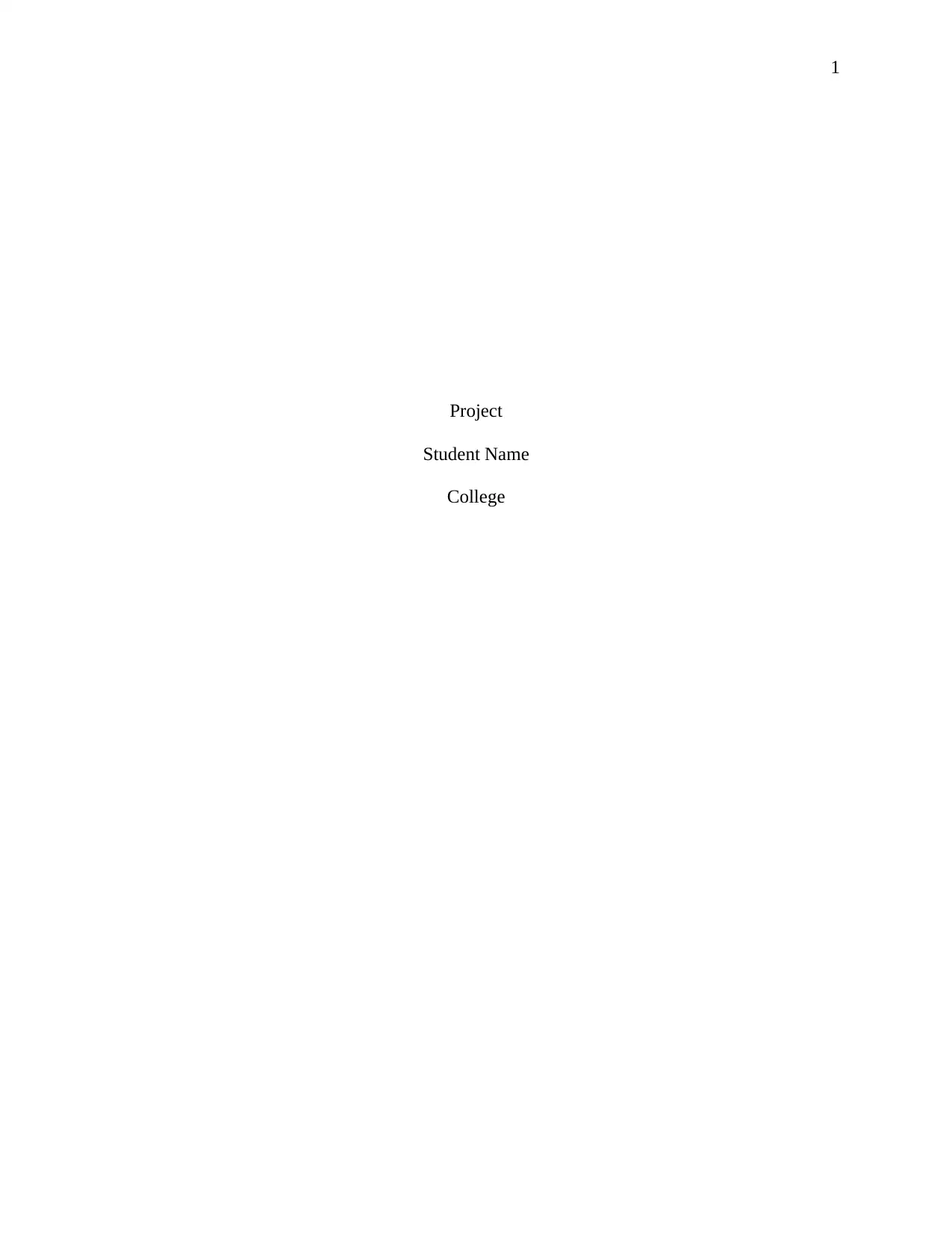
1
Project
Student Name
College
Project
Student Name
College
Paraphrase This Document
Need a fresh take? Get an instant paraphrase of this document with our AI Paraphraser
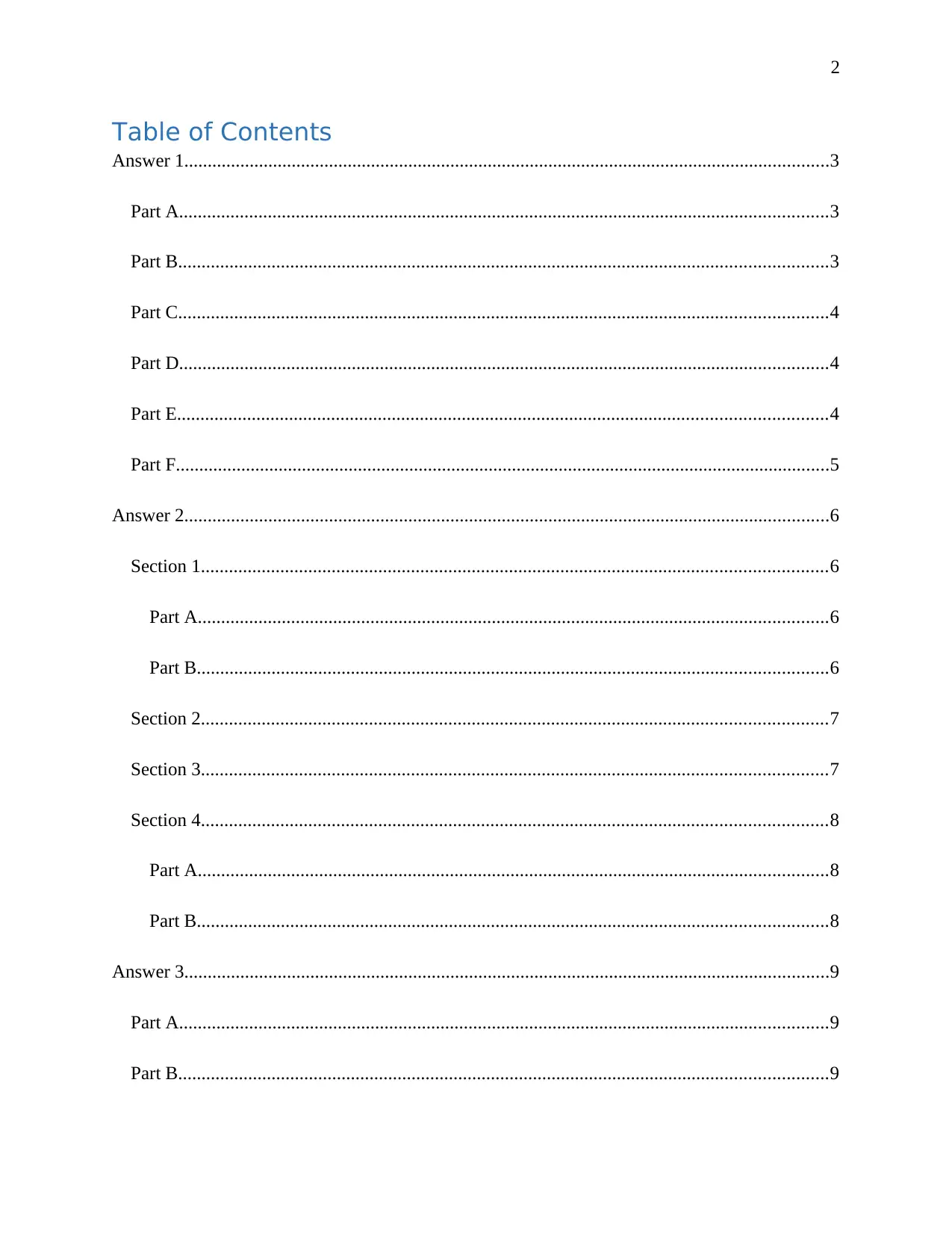
2
Table of Contents
Answer 1..........................................................................................................................................3
Part A...........................................................................................................................................3
Part B...........................................................................................................................................3
Part C...........................................................................................................................................4
Part D...........................................................................................................................................4
Part E...........................................................................................................................................4
Part F............................................................................................................................................5
Answer 2..........................................................................................................................................6
Section 1......................................................................................................................................6
Part A.......................................................................................................................................6
Part B.......................................................................................................................................6
Section 2......................................................................................................................................7
Section 3......................................................................................................................................7
Section 4......................................................................................................................................8
Part A.......................................................................................................................................8
Part B.......................................................................................................................................8
Answer 3..........................................................................................................................................9
Part A...........................................................................................................................................9
Part B...........................................................................................................................................9
Table of Contents
Answer 1..........................................................................................................................................3
Part A...........................................................................................................................................3
Part B...........................................................................................................................................3
Part C...........................................................................................................................................4
Part D...........................................................................................................................................4
Part E...........................................................................................................................................4
Part F............................................................................................................................................5
Answer 2..........................................................................................................................................6
Section 1......................................................................................................................................6
Part A.......................................................................................................................................6
Part B.......................................................................................................................................6
Section 2......................................................................................................................................7
Section 3......................................................................................................................................7
Section 4......................................................................................................................................8
Part A.......................................................................................................................................8
Part B.......................................................................................................................................8
Answer 3..........................................................................................................................................9
Part A...........................................................................................................................................9
Part B...........................................................................................................................................9
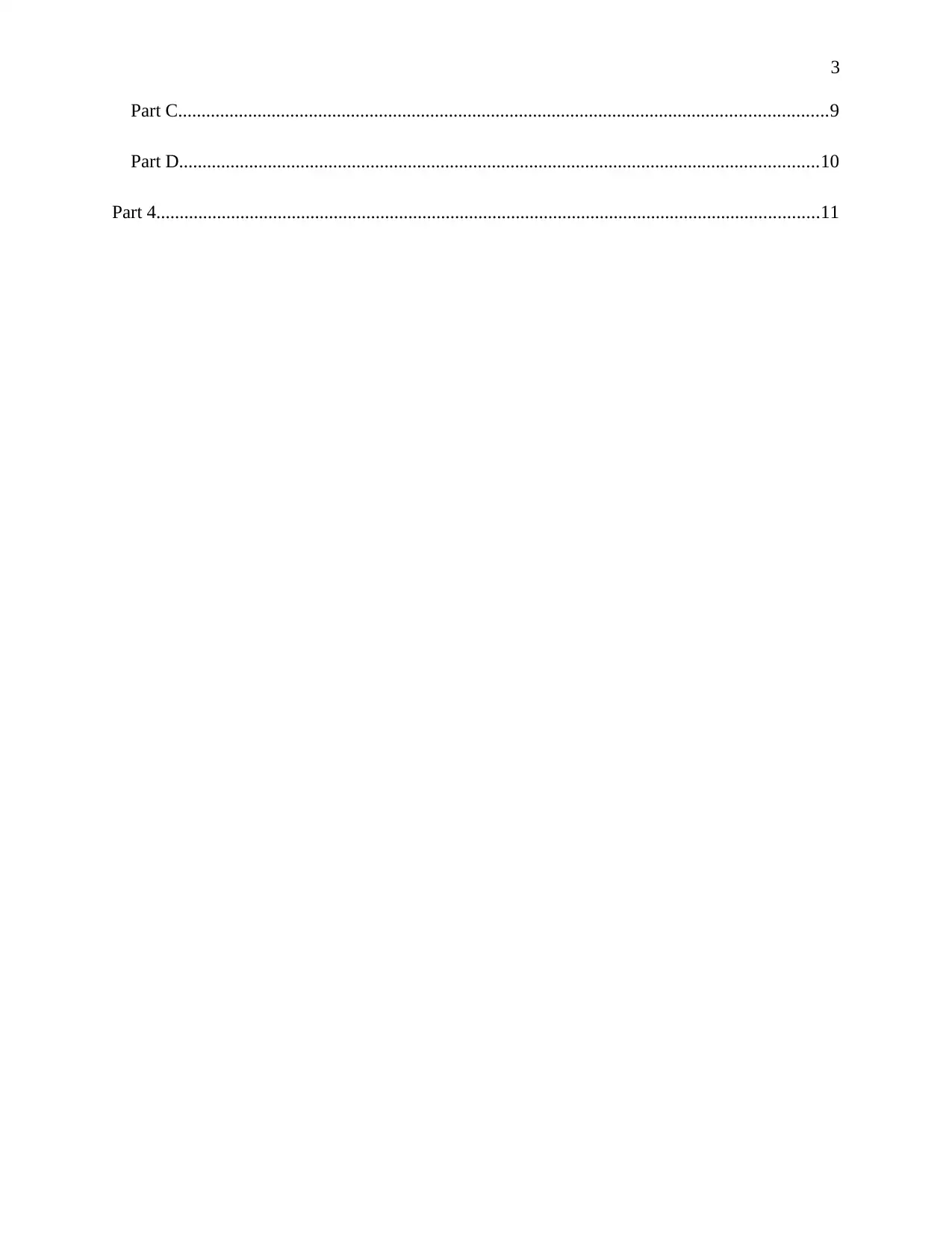
3
Part C...........................................................................................................................................9
Part D.........................................................................................................................................10
Part 4..............................................................................................................................................11
Part C...........................................................................................................................................9
Part D.........................................................................................................................................10
Part 4..............................................................................................................................................11
⊘ This is a preview!⊘
Do you want full access?
Subscribe today to unlock all pages.

Trusted by 1+ million students worldwide

4
Answer 1
Part A
Direct material cost = £160,000 / 120,000 = £1,333.33
Direct labor cost = £80,000 / 120,000 = £666.67
Budgeted Income Statement
Sales (120 x 5000) £ 600,000.00
Less: Variable cost
Direct Material £ 160,000.00
Direct Labour £ 80,000.00
Direct selling cost (120 x 300) £ 36,000.00
Contribution £ 324,000.00
Less: Fixed overhead
Manufacturing overhead £ 220,000.00
Selling, general and administrative £ 30,000.00
Operating Profit Before Tax £ 74,000.00
Part B
Variable cost per unit = Direct material cost + Direct labor cost + Direct selling cost
= 1333.33 + 666.67 + 300
= 2300
Operating leverage
= (Quantity * (Price – Variable Cost))/ (Quantity * (Price – Variable Cost) -Fixed Cot)
= (100 * (5000 – 2300))/ (100 * (5000 – 2300) – 250,000)
= 270,000-20,000
= 13.5 or 1350%
Answer 1
Part A
Direct material cost = £160,000 / 120,000 = £1,333.33
Direct labor cost = £80,000 / 120,000 = £666.67
Budgeted Income Statement
Sales (120 x 5000) £ 600,000.00
Less: Variable cost
Direct Material £ 160,000.00
Direct Labour £ 80,000.00
Direct selling cost (120 x 300) £ 36,000.00
Contribution £ 324,000.00
Less: Fixed overhead
Manufacturing overhead £ 220,000.00
Selling, general and administrative £ 30,000.00
Operating Profit Before Tax £ 74,000.00
Part B
Variable cost per unit = Direct material cost + Direct labor cost + Direct selling cost
= 1333.33 + 666.67 + 300
= 2300
Operating leverage
= (Quantity * (Price – Variable Cost))/ (Quantity * (Price – Variable Cost) -Fixed Cot)
= (100 * (5000 – 2300))/ (100 * (5000 – 2300) – 250,000)
= 270,000-20,000
= 13.5 or 1350%
Paraphrase This Document
Need a fresh take? Get an instant paraphrase of this document with our AI Paraphraser

5
Part C
Break-even = Fixed Cost / Contribution margin
= £250,000 / (£324,000 / 120)
= 92.59
= 93 units
Part D
Budgeted residual income = £5,000
Budgeted operating income = £74,000
Budgeted interest cost = £74,000 - £5,000 = £69,000
Invested amount = Interest cost / Cost of capital
= £69,000 / 10%
= £690,000
Part E
Budgeted Income Statement
Sales (120 x 5000) £ 600,000.00
Cost of goods sold
Direct Material £ 160,000.00
Direct Labour £ 80,000.00
Gross Margin £ 360,000.00
Selling, general and administrative
Fixed £ 30,000.00
Variable £ 36,000.00
Manufacturing overhead £ 220,000.00
Operating Profit Before Tax £ 74,000.00
Part C
Break-even = Fixed Cost / Contribution margin
= £250,000 / (£324,000 / 120)
= 92.59
= 93 units
Part D
Budgeted residual income = £5,000
Budgeted operating income = £74,000
Budgeted interest cost = £74,000 - £5,000 = £69,000
Invested amount = Interest cost / Cost of capital
= £69,000 / 10%
= £690,000
Part E
Budgeted Income Statement
Sales (120 x 5000) £ 600,000.00
Cost of goods sold
Direct Material £ 160,000.00
Direct Labour £ 80,000.00
Gross Margin £ 360,000.00
Selling, general and administrative
Fixed £ 30,000.00
Variable £ 36,000.00
Manufacturing overhead £ 220,000.00
Operating Profit Before Tax £ 74,000.00
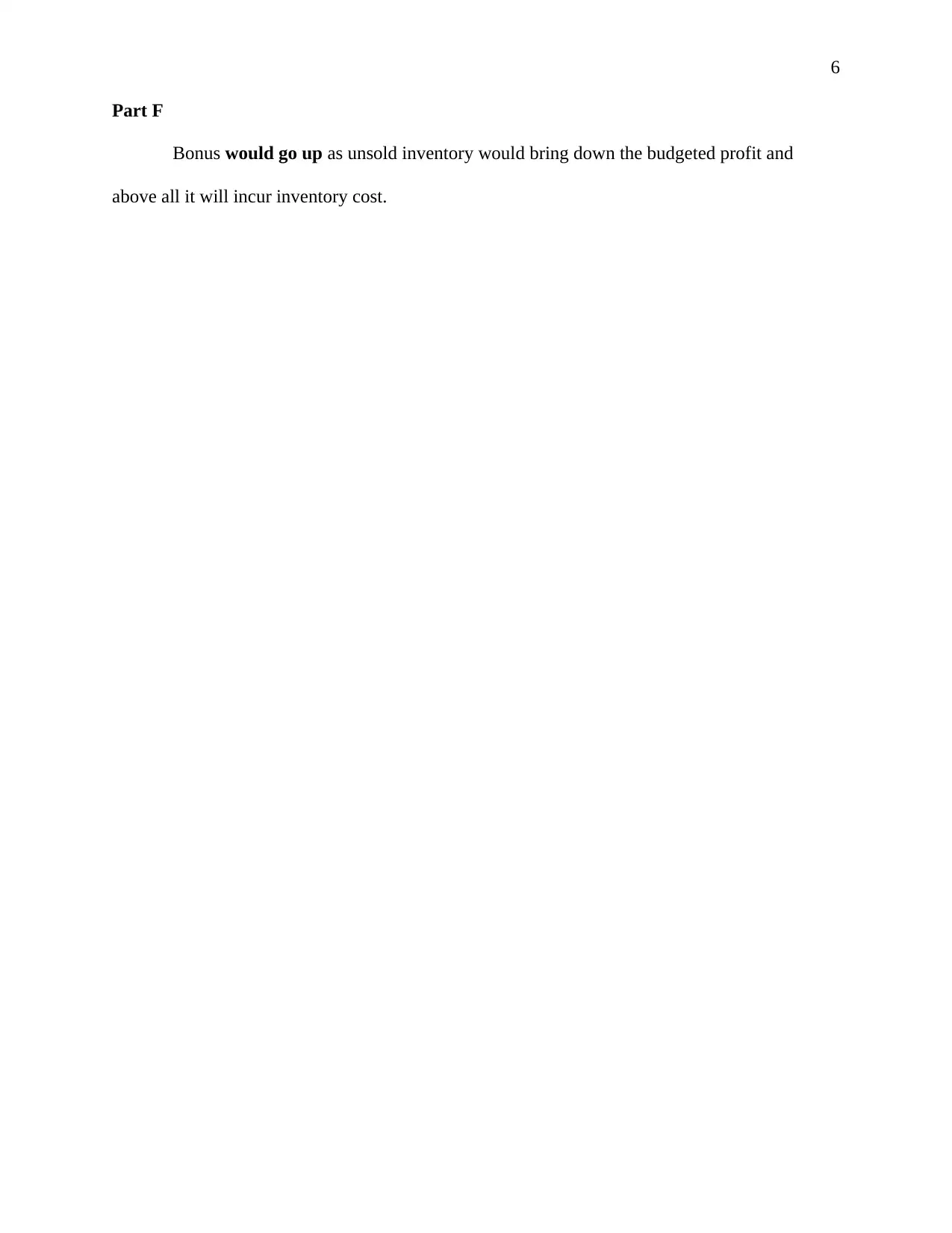
6
Part F
Bonus would go up as unsold inventory would bring down the budgeted profit and
above all it will incur inventory cost.
Part F
Bonus would go up as unsold inventory would bring down the budgeted profit and
above all it will incur inventory cost.
⊘ This is a preview!⊘
Do you want full access?
Subscribe today to unlock all pages.

Trusted by 1+ million students worldwide
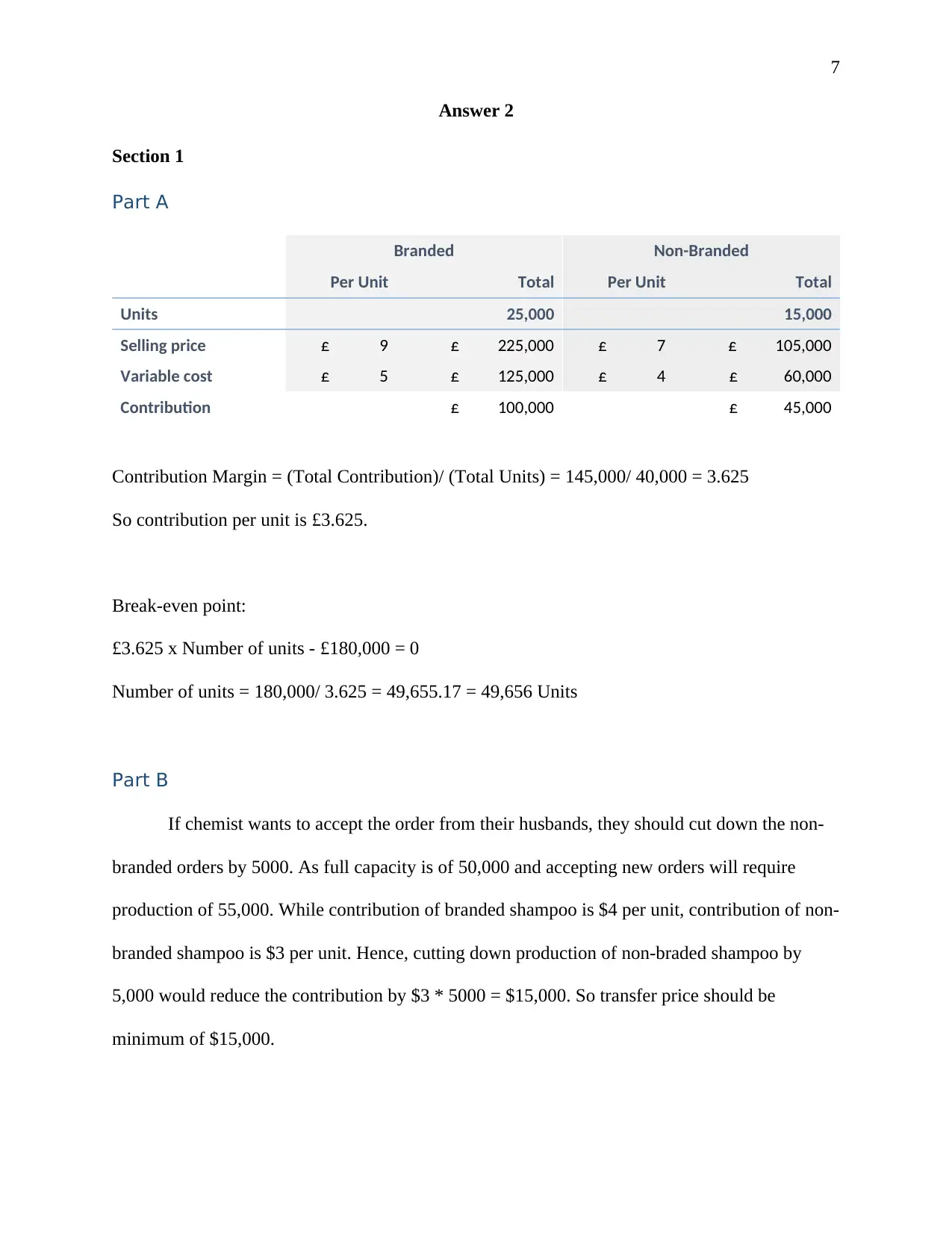
7
Answer 2
Section 1
Part A
Branded Non-Branded
Per Unit Total Per Unit Total
Units 25,000 15,000
Selling price £ 9 £ 225,000 £ 7 £ 105,000
Variable cost £ 5 £ 125,000 £ 4 £ 60,000
Contribution £ 100,000 £ 45,000
Contribution Margin = (Total Contribution)/ (Total Units) = 145,000/ 40,000 = 3.625
So contribution per unit is £3.625.
Break-even point:
£3.625 x Number of units - £180,000 = 0
Number of units = 180,000/ 3.625 = 49,655.17 = 49,656 Units
Part B
If chemist wants to accept the order from their husbands, they should cut down the non-
branded orders by 5000. As full capacity is of 50,000 and accepting new orders will require
production of 55,000. While contribution of branded shampoo is $4 per unit, contribution of non-
branded shampoo is $3 per unit. Hence, cutting down production of non-braded shampoo by
5,000 would reduce the contribution by $3 * 5000 = $15,000. So transfer price should be
minimum of $15,000.
Answer 2
Section 1
Part A
Branded Non-Branded
Per Unit Total Per Unit Total
Units 25,000 15,000
Selling price £ 9 £ 225,000 £ 7 £ 105,000
Variable cost £ 5 £ 125,000 £ 4 £ 60,000
Contribution £ 100,000 £ 45,000
Contribution Margin = (Total Contribution)/ (Total Units) = 145,000/ 40,000 = 3.625
So contribution per unit is £3.625.
Break-even point:
£3.625 x Number of units - £180,000 = 0
Number of units = 180,000/ 3.625 = 49,655.17 = 49,656 Units
Part B
If chemist wants to accept the order from their husbands, they should cut down the non-
branded orders by 5000. As full capacity is of 50,000 and accepting new orders will require
production of 55,000. While contribution of branded shampoo is $4 per unit, contribution of non-
branded shampoo is $3 per unit. Hence, cutting down production of non-braded shampoo by
5,000 would reduce the contribution by $3 * 5000 = $15,000. So transfer price should be
minimum of $15,000.
Paraphrase This Document
Need a fresh take? Get an instant paraphrase of this document with our AI Paraphraser

8
Section 2
Billing rate: $360 per hour
Total fixed cost: $1,600,000
Break-even sales revenue: $3,600,000
Break-even sales = (Fixed price / Contribution) * Billing rate per hour
$3,600,000 = ($1,600,000/ Contribution) * $360
Contribution = $160 per hour
Variable cost = Price – contribution
= $360 - $160
= $200
Section 3
The tax laws are written in the US to provide that if an employee gets an “at the money”
option as part of their compensation, they do not have to pay taxes on it. Companies issue
options “at the money” to avoid generating income to their employees that would require them to
pay taxes on the grant.
Section 2
Billing rate: $360 per hour
Total fixed cost: $1,600,000
Break-even sales revenue: $3,600,000
Break-even sales = (Fixed price / Contribution) * Billing rate per hour
$3,600,000 = ($1,600,000/ Contribution) * $360
Contribution = $160 per hour
Variable cost = Price – contribution
= $360 - $160
= $200
Section 3
The tax laws are written in the US to provide that if an employee gets an “at the money”
option as part of their compensation, they do not have to pay taxes on it. Companies issue
options “at the money” to avoid generating income to their employees that would require them to
pay taxes on the grant.
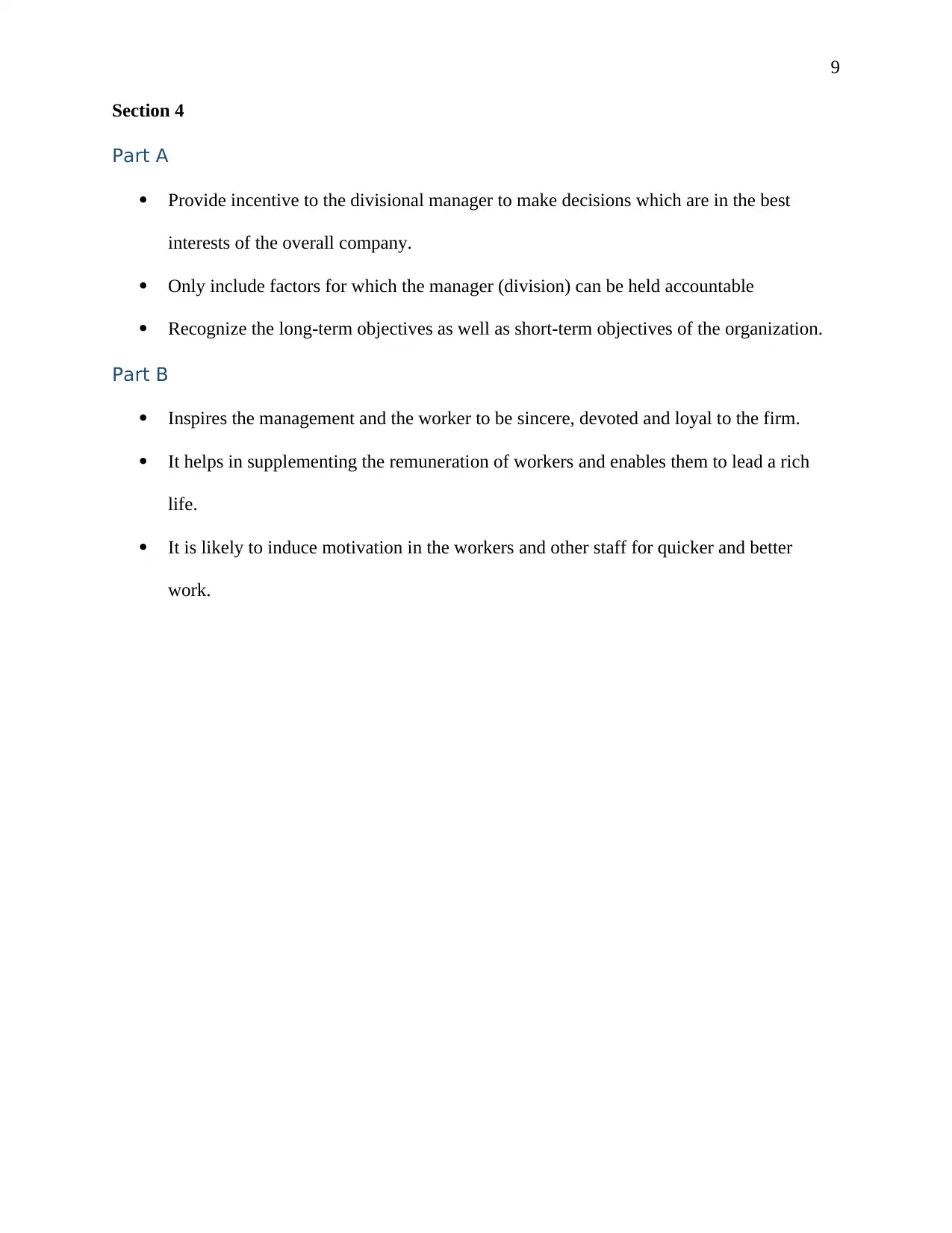
9
Section 4
Part A
Provide incentive to the divisional manager to make decisions which are in the best
interests of the overall company.
Only include factors for which the manager (division) can be held accountable
Recognize the long-term objectives as well as short-term objectives of the organization.
Part B
Inspires the management and the worker to be sincere, devoted and loyal to the firm.
It helps in supplementing the remuneration of workers and enables them to lead a rich
life.
It is likely to induce motivation in the workers and other staff for quicker and better
work.
Section 4
Part A
Provide incentive to the divisional manager to make decisions which are in the best
interests of the overall company.
Only include factors for which the manager (division) can be held accountable
Recognize the long-term objectives as well as short-term objectives of the organization.
Part B
Inspires the management and the worker to be sincere, devoted and loyal to the firm.
It helps in supplementing the remuneration of workers and enables them to lead a rich
life.
It is likely to induce motivation in the workers and other staff for quicker and better
work.
⊘ This is a preview!⊘
Do you want full access?
Subscribe today to unlock all pages.

Trusted by 1+ million students worldwide

10
Answer 3
Part A
Advantages:
Simplicity
Sales data is available and easily accessible
Costs are allocated based on revenue-generating power of the individual products
Disadvantages:
Doesn't consider separable costs beyond split off
May not be a market for product at split off
It’s not a good choice as it may represent the distorted picture of profitability and that may
result in erroneous decision.
Part B
Overhead rate = Total overhead / No of units
= $1,422,700 / (900,000 + 2,100,000)
= $1,422,700/ 3,000,000
= $0.474
Part C
Product A Product B
Selling price / unit $3.00 $2.15
Direct labor cost / unit $0.50 $0.50
Direct materials cost / unit $0.75 $0.50
Overhead cost / unit $0.47 $0.47
Cost of goods sold $1.72 $1.47
Gross profit / unit $1.28 $0.68
Answer 3
Part A
Advantages:
Simplicity
Sales data is available and easily accessible
Costs are allocated based on revenue-generating power of the individual products
Disadvantages:
Doesn't consider separable costs beyond split off
May not be a market for product at split off
It’s not a good choice as it may represent the distorted picture of profitability and that may
result in erroneous decision.
Part B
Overhead rate = Total overhead / No of units
= $1,422,700 / (900,000 + 2,100,000)
= $1,422,700/ 3,000,000
= $0.474
Part C
Product A Product B
Selling price / unit $3.00 $2.15
Direct labor cost / unit $0.50 $0.50
Direct materials cost / unit $0.75 $0.50
Overhead cost / unit $0.47 $0.47
Cost of goods sold $1.72 $1.47
Gross profit / unit $1.28 $0.68
Paraphrase This Document
Need a fresh take? Get an instant paraphrase of this document with our AI Paraphraser
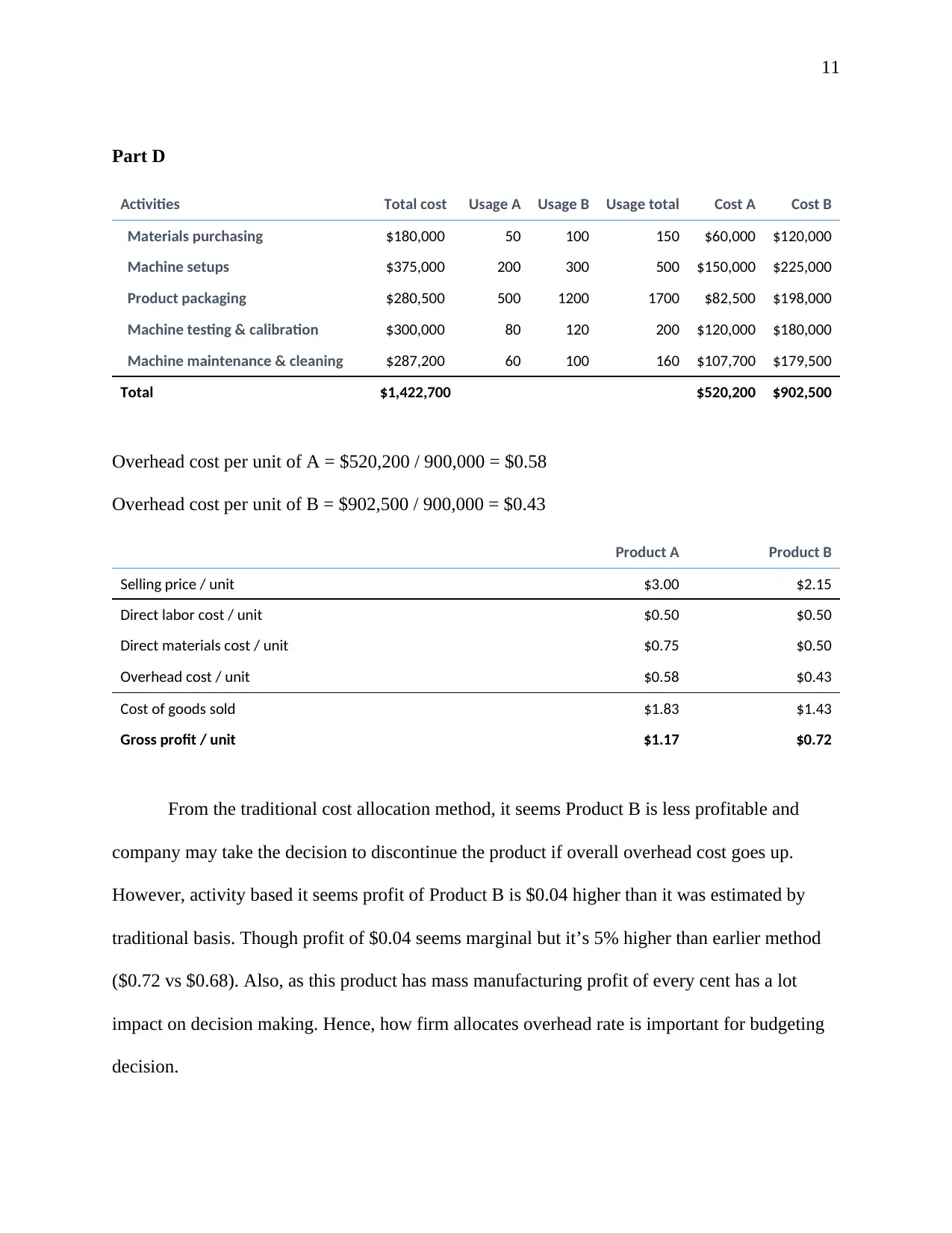
11
Part D
Activities Total cost Usage A Usage B Usage total Cost A Cost B
Materials purchasing $180,000 50 100 150 $60,000 $120,000
Machine setups $375,000 200 300 500 $150,000 $225,000
Product packaging $280,500 500 1200 1700 $82,500 $198,000
Machine testing & calibration $300,000 80 120 200 $120,000 $180,000
Machine maintenance & cleaning $287,200 60 100 160 $107,700 $179,500
Total $1,422,700 $520,200 $902,500
Overhead cost per unit of A = $520,200 / 900,000 = $0.58
Overhead cost per unit of B = $902,500 / 900,000 = $0.43
Product A Product B
Selling price / unit $3.00 $2.15
Direct labor cost / unit $0.50 $0.50
Direct materials cost / unit $0.75 $0.50
Overhead cost / unit $0.58 $0.43
Cost of goods sold $1.83 $1.43
Gross profit / unit $1.17 $0.72
From the traditional cost allocation method, it seems Product B is less profitable and
company may take the decision to discontinue the product if overall overhead cost goes up.
However, activity based it seems profit of Product B is $0.04 higher than it was estimated by
traditional basis. Though profit of $0.04 seems marginal but it’s 5% higher than earlier method
($0.72 vs $0.68). Also, as this product has mass manufacturing profit of every cent has a lot
impact on decision making. Hence, how firm allocates overhead rate is important for budgeting
decision.
Part D
Activities Total cost Usage A Usage B Usage total Cost A Cost B
Materials purchasing $180,000 50 100 150 $60,000 $120,000
Machine setups $375,000 200 300 500 $150,000 $225,000
Product packaging $280,500 500 1200 1700 $82,500 $198,000
Machine testing & calibration $300,000 80 120 200 $120,000 $180,000
Machine maintenance & cleaning $287,200 60 100 160 $107,700 $179,500
Total $1,422,700 $520,200 $902,500
Overhead cost per unit of A = $520,200 / 900,000 = $0.58
Overhead cost per unit of B = $902,500 / 900,000 = $0.43
Product A Product B
Selling price / unit $3.00 $2.15
Direct labor cost / unit $0.50 $0.50
Direct materials cost / unit $0.75 $0.50
Overhead cost / unit $0.58 $0.43
Cost of goods sold $1.83 $1.43
Gross profit / unit $1.17 $0.72
From the traditional cost allocation method, it seems Product B is less profitable and
company may take the decision to discontinue the product if overall overhead cost goes up.
However, activity based it seems profit of Product B is $0.04 higher than it was estimated by
traditional basis. Though profit of $0.04 seems marginal but it’s 5% higher than earlier method
($0.72 vs $0.68). Also, as this product has mass manufacturing profit of every cent has a lot
impact on decision making. Hence, how firm allocates overhead rate is important for budgeting
decision.
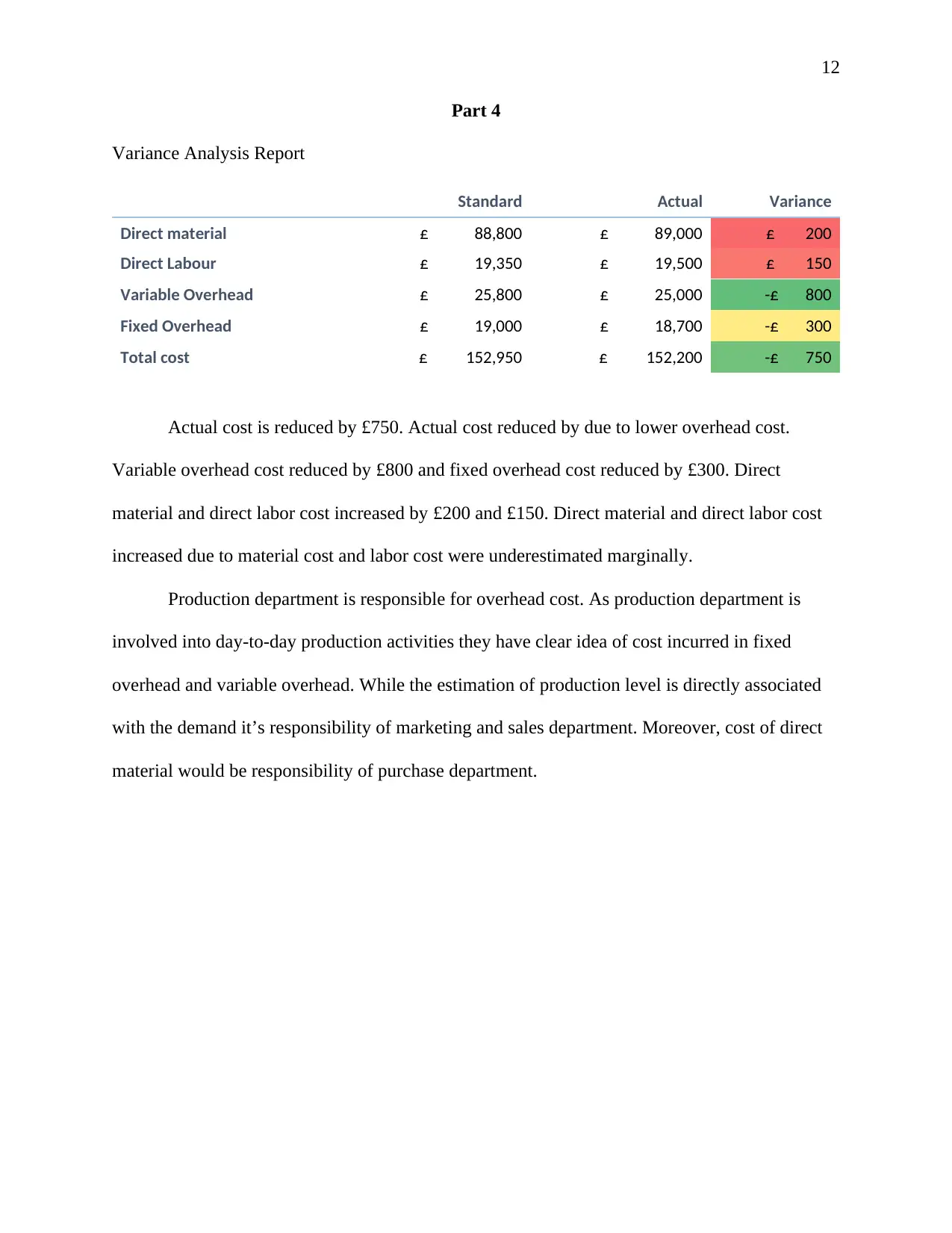
12
Part 4
Variance Analysis Report
Standard Actual Variance
Direct material £ 88,800 £ 89,000 £ 200
Direct Labour £ 19,350 £ 19,500 £ 150
Variable Overhead £ 25,800 £ 25,000 -£ 800
Fixed Overhead £ 19,000 £ 18,700 -£ 300
Total cost £ 152,950 £ 152,200 -£ 750
Actual cost is reduced by £750. Actual cost reduced by due to lower overhead cost.
Variable overhead cost reduced by £800 and fixed overhead cost reduced by £300. Direct
material and direct labor cost increased by £200 and £150. Direct material and direct labor cost
increased due to material cost and labor cost were underestimated marginally.
Production department is responsible for overhead cost. As production department is
involved into day-to-day production activities they have clear idea of cost incurred in fixed
overhead and variable overhead. While the estimation of production level is directly associated
with the demand it’s responsibility of marketing and sales department. Moreover, cost of direct
material would be responsibility of purchase department.
Part 4
Variance Analysis Report
Standard Actual Variance
Direct material £ 88,800 £ 89,000 £ 200
Direct Labour £ 19,350 £ 19,500 £ 150
Variable Overhead £ 25,800 £ 25,000 -£ 800
Fixed Overhead £ 19,000 £ 18,700 -£ 300
Total cost £ 152,950 £ 152,200 -£ 750
Actual cost is reduced by £750. Actual cost reduced by due to lower overhead cost.
Variable overhead cost reduced by £800 and fixed overhead cost reduced by £300. Direct
material and direct labor cost increased by £200 and £150. Direct material and direct labor cost
increased due to material cost and labor cost were underestimated marginally.
Production department is responsible for overhead cost. As production department is
involved into day-to-day production activities they have clear idea of cost incurred in fixed
overhead and variable overhead. While the estimation of production level is directly associated
with the demand it’s responsibility of marketing and sales department. Moreover, cost of direct
material would be responsibility of purchase department.
⊘ This is a preview!⊘
Do you want full access?
Subscribe today to unlock all pages.

Trusted by 1+ million students worldwide
1 out of 12
Your All-in-One AI-Powered Toolkit for Academic Success.
+13062052269
info@desklib.com
Available 24*7 on WhatsApp / Email
![[object Object]](/_next/static/media/star-bottom.7253800d.svg)
Unlock your academic potential
© 2024 | Zucol Services PVT LTD | All rights reserved.